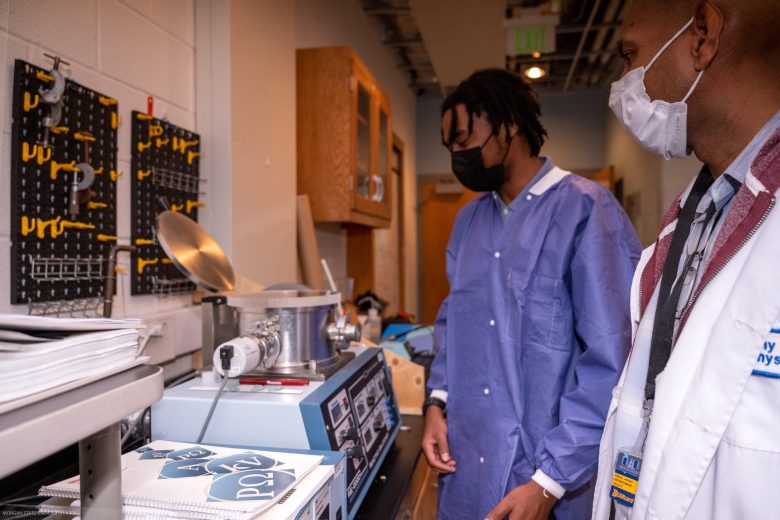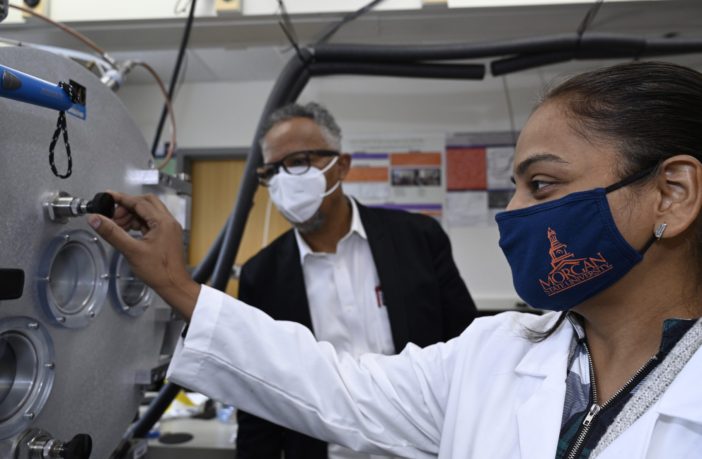By Morgan State U
As part of an overall effort to enhance its national and international reputation as a recognized research university and raise its Carnegie classification to R1 (highest research) status by 2031, Morgan State University convened a national Blue-Ribbon Panel on STEM Research Expansion. Representing a diverse gathering of some of the country’s leading scholars and members of the scientific research community, the panel met over a two-day period with University administrators and faculty to learn more about Morgan’s strategic plan and capabilities, and to evaluate potential “Peaks of Excellence,” before offering strategic recommendations to achieve University goals. The convening of the Blue-Ribbon Panel marks the first such effort of its kind in Morgan’s history.
“We invited 12 national leaders in the STEM space to come learn more about the cutting-edge research that we are doing at Morgan and to listen to our plans for the future, as we wanted to be certain of the direction that we are taking in identifying and establishing core research areas that will distinguish Morgan from other institutions,” said David K. Wilson, president of Morgan State University. “They listened and provided thoughtful feedback on how we can bolster our strengths in key fields of research while growing in other areas that present the most promise. With the resources made available by way of Maryland’s recent settlement of the HBCU lawsuit, and the advice received from these experts, we will be able to expand our research efforts and enhance our environment of innovation to usher in the next generation of minority scientists, particularly those who are African American.”

Drawn from diverse backgrounds, organizations and research disciplines, the Blue-Ribbon panelists consisted of the following notable individuals
Carol Espy-Wilson, D., professor in the Electrical and Computer Engineering Department and the Institute for Systems Research at the University of Maryland, College Park.
Craig N. McLean, acting chief scientist for science and technology priorities and assistant administrator for Oceanic and Atmospheric Research at the National Oceanic and Atmospheric Administration (NOAA).
Claudia Rankins, D., an immediate past program officer in the Directorate for Education and Human Resources at the National Science Foundation, managing the HBCU undergraduate program and the Centers for Research Excellence in Science and Technology.
Eugene M. DeLoatch, D., dean emeritus and founding dean for Morgan’s Clarence M. Mitchell Jr. School of Engineering, and past president and Fellow for the American Society of Engineering Education.
Hratch Semerjian,D., chief scientist emeritus for NIST, and a member of the National Academy of Engineering.
Isiah M. Warner, D., an analytical/materials chemist with focal research in fluorescence spectroscopy, organized media and ionic liquid chemistry, who currently serves as vice president for Strategic Initiatives, and a Boyd Professor and Phillip W. West Professor of analytical and environmental chemistry at Louisiana State University.
Juan E. Gilbert,D., the Andrew Banks Family preeminence endowed professor and department chair for Computer and Information Science and Engineering at the University of Florida.
Landon Taylor, founder and chairman of Base 11, a nonprofit 501(c)3 STEM workforce and entrepreneur accelerator.
Mahlet N. Mesfin, D., senior advisor for policy planning to the Secretary of State for the U.S. Department of State and a former visiting scholar at the Penn Biden Center for Diplomacy and Global Engagement.
Rhonda R. Franklin, D., professor of electrical and computer engineering at the University of Minnesota, with a research focus on microelectronic mechanical structures in radio and microwave applications.
Sylvester James Gates Jr., D., a National Medal of Science-winning theoretical physicist, the Ford Foundation professor of physics and director of the Brown Theoretical Physics Center at Brown University. He is also an affiliate professor of mathematics and a faculty Fellow at Brown’s Watson Institute for International Studies and Public Affairs.
William D. Phillips, Ph.D., a Nobel Prize-winning scientist and Fellow at the National Institute of Standards and Technology (NIST), and a distinguished professor of physics within the Joint Quantum Institute at the University of Maryland, College Park.
In September, the Panel participated in two consecutive days of hybrid meetings with Morgan administrators and a group of professors and researchers representing Morgan’s School of Engineering; School of Computer, Mathematical and Natural Sciences; School of Community Health and Policy; College of Liberal Arts; and Division of Research and Economic Development. Led by President Wilson and Willie E. May, Ph.D., vice president for Research and Economic Development at Morgan, the five-session examination enabled the University to present its research and STEM assets to the panel, in addition to highlighting eight areas identified as potential “Peaks of Excellence,” that with the right investments, might establish a nationally-recognized footprint.

“Achieving R1 research status over the next 10 years is a critical component of the University’s strategic plan that will enable us to attract new students of all nationalities and expose them to the areas of STEM, and select areas within the humanities, that will likely underpin the careers of the future,” said Dr. May. “We brought in these visionary leaders and thinkers to learn more about our capabilities and to evaluate the path we are on, while providing us with critical insights toward achieving our goals.”
Included among the University’s current research assets presented to the Panel were its Center for Predictive Analytics, cybersecurity for IoT (Internet of Things) devices, brain science, urban health equity programs and STEM education programs, while the pioneering and rising areas of advanced manufacturing, engineering biology, artificial intelligence and machine learning, data science and data analytics, digital engineering, quantum education and literacy, climate science, and hypersonics and propulsion systems were identified as potential “Peaks of Excellence” — promising areas for new investment.
The panel members — including some who have significant experience in planning and implementing the expansion of universities’ research portfolios — recommended key strategies that included reducing teaching loads to free up more time for research, creating teaching courses for faculty researchers, offering strategic faculty development plans for new hires, recruiting top researchers by providing incentives such as start-up funding, eliminating the distinction between teaching and research, and bringing advanced research facilities online.
It was also recommended that Morgan establish a STEM Research Center to oversee the development and management of all STEM-related programming from the perspective of social justice and equity. The Center would create means for researchers to interact with social scientists and educators to translate their research into policy and into undergraduate research education. Of Morgan’s eight potential Peaks of Excellence, “Trustworthy Artificial Intelligence” and “Equitable AI and Analytics” were identified as those most likely to make the highest impact and best suited for inclusion in a joint center of excellence with shared approaches, tools, skill sets and goals. Climate science offered another very promising area of opportunity, concluded the panel.
“Our meeting with the team at Morgan was successful overall, as it allowed us an opportunity to evaluate the University’s unique strengths, perspective and credibility,” said Dr. Semerjian, who served as the Panel’s chair. “The potential for establishing the foundation for a world-class research university is within grasp. This can be achieved through a few strategic partnerships and strengthening research areas that take advantage of the broad backgrounds, expertise and diversity of the University’s faculty. If done tactically and with a great degree of intentionality, Morgan can set itself apart and establish programs of national impact and visibility.”
Some members of the Blue-Ribbon Panel will continue to work with Morgan as part of a special strategic task force, advising the University along its journey to R1 research status.
About Morgan
Morgan State University, founded in 1867, is a Carnegie-classified high research (R2) institution offering nearly 140 academic programs leading to degrees from the baccalaureate to the doctorate. As Maryland’s Preeminent Public Urban Research University, and the only university to have its entire campus designated as a National Treasure by the National Trust for Historic Preservation, Morgan serves a multiethnic and multiracial student body and seeks to ensure that the doors of higher education are opened as wide as possible to as many as possible. For more information about Morgan State University, visit www.morgan.edu
Help us Continue to tell OUR Story and join the AFRO family as a member – subscribers are now members! Join here!



